Burlington’s Ice Rink Energy Competition
The City of Burlington's Ice Rink Energy Competition employs a low cost, easily replicable approach to significantly reduce energy consumption, associated greenhouse gases (GHG) and energy costs. A friendly competition to reduce energy at eight of the city's ice rinks helps change behaviours among staff and users, improves facility performance, and extends equipment life without sacrificing facility service levels or user satisfaction. Designated a Landmark case study in 2013.
Background
Note: To minimize site maintenance costs, all Tools of Change case studies are written in the past tense, even if they are ongoing programs, as is the case with this one.
Energy inventories prepared by the City of Burlington in the early 2000s showed that buildings were the city's highest energy consuming assets; of those buildings, ice rinks used the most energy and were the greatest sources of greenhouse gas emissions. This wasn't surprising as ice rinks require large amounts of energy for lighting, heating, forming ice surfaces, and operating refrigeration equipment. In addition, they require careful balancing of heating (for user comfort) and cooling (for ideal ice conditions).
Many of the city's arenas had been recently retrofitted with high-efficiency equipment and refrigeration control systems. Although these upgrades reduced energy consumption, the city's energy management staff felt that the arenas were not reaching their full potential. For example, despite multiple staff training sessions on the use of building automation systems (BAS), cooling systems were often not set back during non-use periods to save energy. Staff determined that this was to avoid user complaints.
Energy management staff pitched the idea of a competition to senior management, including the city's mayor. They strongly backed the initiative, believing that the competition would not only be a low-cost measure, it would also inspire all participants to reduce operating costs and provide momentum for future savings.
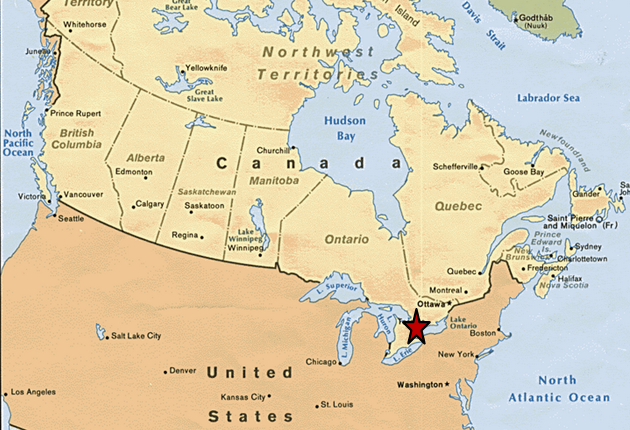 Map courtesy of mapcruzin.com
Map courtesy of mapcruzin.com
Setting Objectives
Prior to the competition, the city completed an energy management plan and, as part of that plan, had conducted energy audits of all of the facilities. The audits provided a list of opportunities from which participants could start, and estimates of how well the arenas could perform if more attention was paid to utility consumption.
Based on those audit findings, energy management staff set a 15% reduction in energy consumption as the goal for all facilities.
Getting Informed
Energy management staff reviewed relevant literature on topics such as community-based social marketing (CBSM) and theories of persuasion. Staff also solicited feedback from other institutions about their experiences with similar initiatives.
Identifying Barriers
Buy-in from facility operating staff was the main barrier to reducing energy consumption. By observing staff and conducting informal intercept surveys, energy management staff discovered that these staff were either inconsistent in their energy conserving behaviors, or were not conforming to the standards set forth in their training.
The key barriers were:
- A perceived increase in operator work for energy efficiency (They would have to change set business processes.)
- Unclear benefits for energy efficiency. For example, does turning off the ice making plant for short durations during non-use actually save any energy costs overall?
- Concerns about increase in user complaints regarding facility comfort conditions and ice quality.
- Inconsistencies regarding best operating procedures among the facility operating groups.
- Concerns about user group involvement. For example, a competition with cost reduction as the top motive was perceived as a potential opportunity for user groups to request reduced fees, nullifying any cost saving benefits.
Targeting the Audience
Facility staff was the primary audience for the program as they had the greatest impact on energy using behaviours. To a lesser extent, users of the facilities were also targeted for their support of the competition.
Delivering the Program
Providing a Level Playing Field
Environmental management staff understood that the competition needed to provide a level playing field. To do that, staff needed to determine three things:
- The date range for the competition
- Which facilities would participate, and
- Baseline energy use for each facility.
The date range chosen for the first competition was from February 1 to March 31, 2013. Staff also decided that eight arenas would participate.
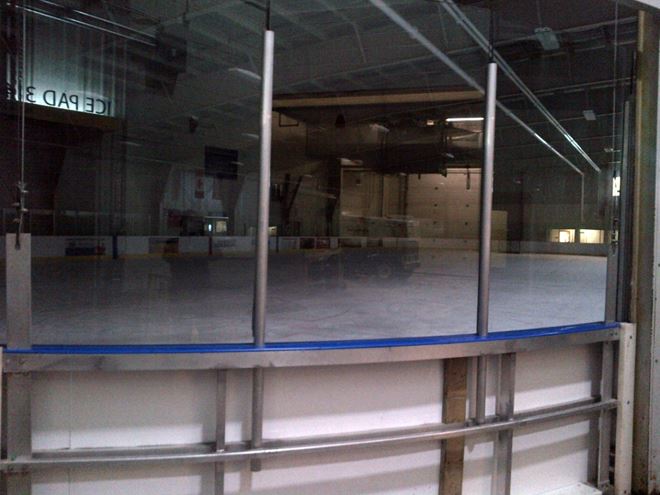
Staff used 2012 utility data, adjusted for weather and use factors, to set a baseline for each arena. They also developed a standardized measure of energy use intensity, as follows.
Energy Use Intensity = (Electricity consumption + natural gas consumption) ÷ (facility area [ft] x facility operating hours).
This allowed each arena to compete based on a fair basis. (Competitions)
Training and Guidelines
Energy management staff also established standard operating procedures for all the rinks, including set points, lighting controls, etc.
Five energy management workshops were then held for all arena staff. The workshops, run by Natural Resources Canada, included a review of the standard operating procedures and were customized for the city's arenas to be specific to the conditions, use and operating hours of a typical facility.
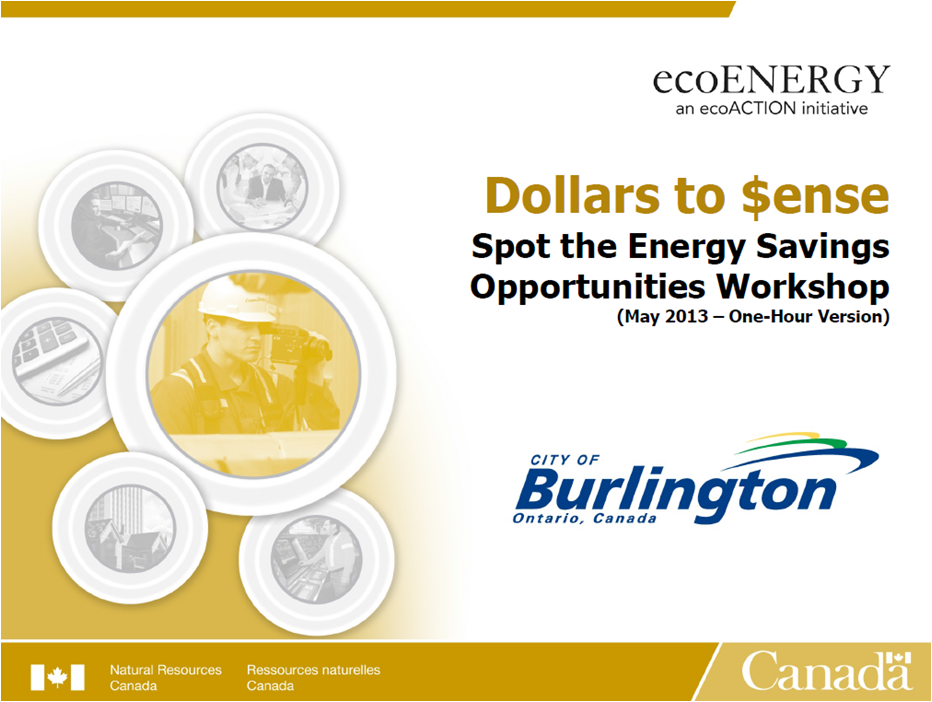
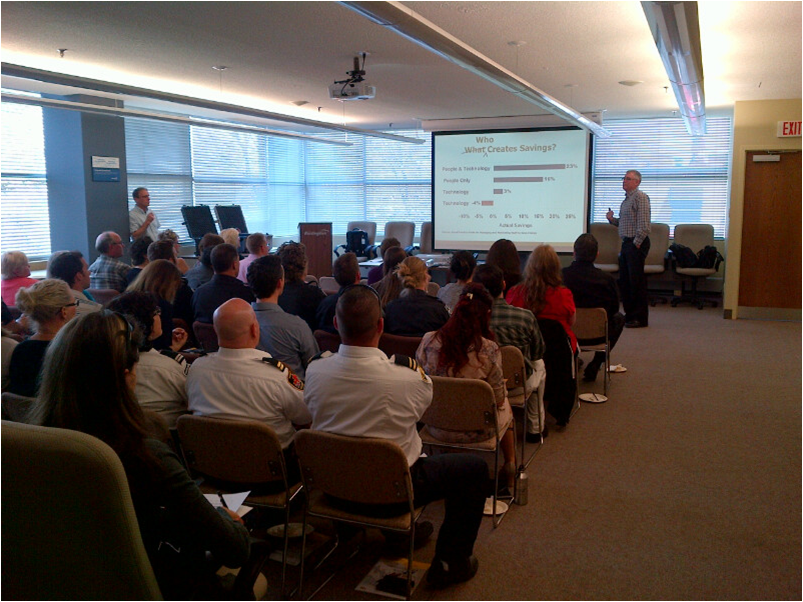
Five energy management workshops were held for all arena staff.
In addition, Burlington held a training "road show" at multiple city facilities and worked with local energy champions in various city departments to encourage attendance. (Vivid, personalized, credible, empowering communications) .png)
Workshop with staff at RPM Arena
Workshop participants were provided with various handouts and an Energy Conservation Handbook that outlined conservation tips and operating procedures.
Communications Campaign
Burlington's corporate energy coordinator managed all communications with arena staff, including those in the city's Parks and Recreation department.
Once the competition began on February 1, 2013, energy reduction information was posted on the city's website and signs were put up in the arenas to visually remind staff of energy reducing behaviors, such as turning off lights and shutting doors to the rink to keep the cold in. These signs also provided information on additional behaviours, such as turning off computers and small desk heaters. In some of the arenas, television monitors advertised the competition along with a continuous loop of other local information. These media helped to inform the public in addition to staff. (Overcoming specific barriers; Prompts; Vivid, credible communications)


Signs served as prompts for target behaviors
Feedback and Recognition
While Burlington did not directly reward the individuals at the winning facility, nor return the savings directly to that arena’s own budget, it did re-invest some of the savings in energy-efficiency equipment at the winning facility. For example, the winning facility was the first to get a new laser control for its Zamboni. The laser helps create a more level, consistent and thinner ice surface that requires less energy to maintain at the desired surface temperature. An award plaque was also presented to the facility staff (Recognition)
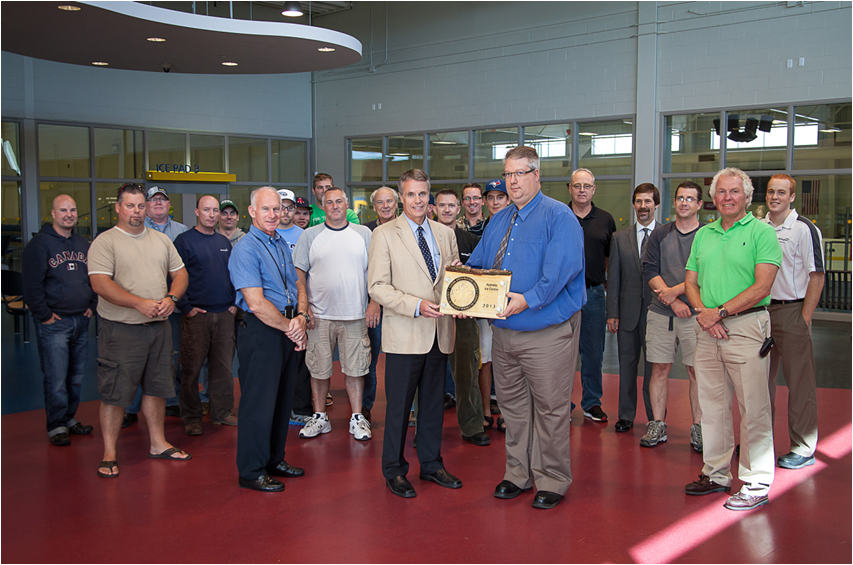
An award plaque was presented to staff at the winning facility
To encourage additional energy saving behaviors, the city continued to provide monthly statements on energy consumption to all facility staff after the competition was completed. (Feedback, Norm appeals, Prompts)
Energy management staff reported that, once facility and operations staff began seeing for themselves the kind of impact they could make on energy consumption, they were more apt to be supportive of the competition and to look for new ways to save energy. (Building motivation over time; Overcoming specific barriers)
Partnerships
Natural Resources Canada (NRCan), the Ontario Power Authority and Union Gas all contributed financial and in-kind resources, such as financial assistance for the workshops and content for brochures and posters.
Financing the Program
Most of the budget for the competition was devoted to staff training. NRCan's Dollars to $ense workshops were used as the training program, and were customized for the ice rinks. Workshop costs totalled $25,900, of which the city contributed $600.
Measuring Achievements
The program impact was measured using actual facility utility bills for the February to March period for 2012 and 2013 (year over year). The bills were adjusted for any variances due to weather and facility utilization. The results were reviewed by the senior management of the participating facilities.
Results
Two of the facilities achieved more than the 15% energy reduction objective. The Appleby arena won the competition, reducing energy by 18% (surpassing the city's objective) and water consumption by 37%.
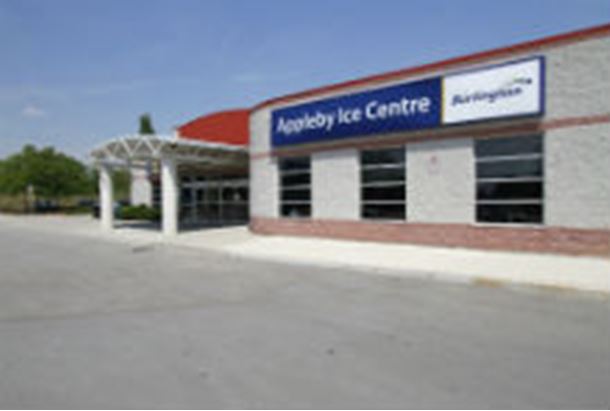
Appleby Ice Centre reduced energy use by 18% and water consumption by 37%.
The overall impact for all eight arenas was about a 9% reduction in electricity and natural gas consumption, and a 24% reduction in water consumption.
Per facility, per year, there was an average reduction of approximately 227,000 equivalent kWh of electricity and natural gas consumption. Potable water consumption was reduced by approximately 2,000 litres per facility per year. The energy savings, excluding water, resulted in avoided GHG emissions of about 45 metric tonnes per facility per year.
Having experienced the competition and its results, facility operations staff became more involved in using the facility control systems and adhering to the standardized operating procedures.
By the end of the competition, the city had saved or eliminated:
- 1.8 million kWh of electricity and natural gas consumption per year.
- 16,100 litres of potable water consumption.
- Greenhouse gas (GHG) emissions of 270 metric tonnes of CO2, the equivalent of avoiding the GHG emissions of 56 vehicles.
- $158,000 per year (based on actual bills.)
By changing people's energy awareness and behaviour, the city achieved a 96% return on investment.
Another benefit was that staff maintained the arena equipment better, increasing its useful life, further reducing energy and GHG emissions, and minimizing the large capital costs associated with equipment replacement. An unexpected result was that facility comfort levels actually improved.
Overall, the competition fostered greater teamwork, camaraderie and focus on basic operations.
Contacts
David Taggart,
Manager, Facility Assets
City of Burlington
Tel. 905-335-7600 x. 7423
David.taggart@burlington.ca
Ahmed Azhari
Coordinator, Project Management, Energy
City of Burlington
Tel. 905-335-7600 x. 7354
Ahmed.azhari@burlington.ca
Website: www.burlington.ca/environment
Notes
Lessons Learned
Competition Yields Results
The city capitalized on people's natural feelings of competitiveness, turning a low-cost approach into significant energy reductions.
Change Behaviour, Change Results
The energy audits showed that, even though the arenas had been upgraded with new high-efficiency equipment, even more could be done from a behaviour standpoint. Compared to the costs of retrofits, changing people's behaviors was by far the fastest and most efficient way to save energy.
Keep Communications Open
The city kept facility staff and operators in the loop in terms of updated technical knowledge and conservation tips. Energy management staff sat in on all the training workshops, which helped build trust among facility operators. This also helped facility staff stay "ahead of the curve" and made it easier for them to accept and implement any new energy efficiency programs. In fact, many facility staff proposed new energy efficiency measures for their arenas.
Don't Micromanage
Facility staff was given the autonomy and control to change what was required within each facility. This helped build feelings of trust among all facility users and a broader sense of ownership in the program.
Top-down Support
Senior managers, including the mayor and council, supported the competition from the beginning and this helped to create buy-in from facility staff.
Landmark Designation
The program described in this case study was designated in 2013. The case study was written by Jay Kassirer in 2014.
Designation as a Landmark (best practice) case study through our peer selection process recognizes programs and social marketing approaches considered to be among the most successful in the world. They are scored by our peer-selection panels based on impact, innovation, replicability and adaptability.
The panel that designated this program consisted of:
- Jon Connor, Federation of Canadian Municipalities
- Arien Korteland, BC Hydro
- Doug McKenzie-Mohr, McKenzie-Mohr Associates
- Edward Vine of Lawrence Berkeley National Laboratories